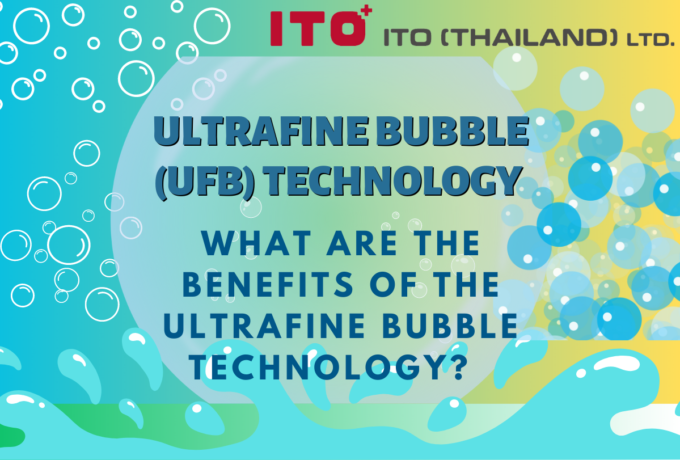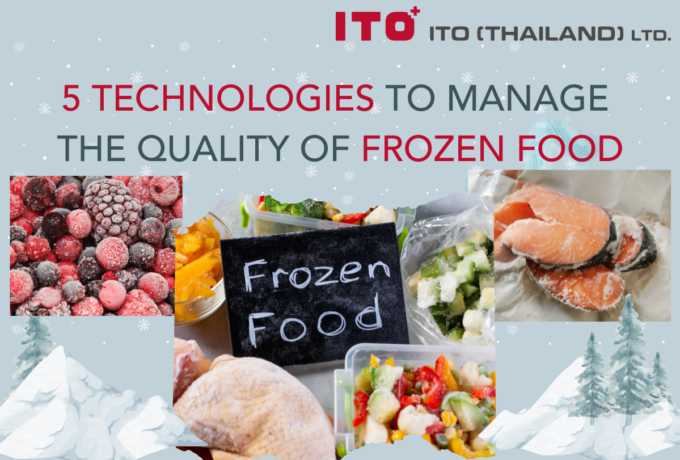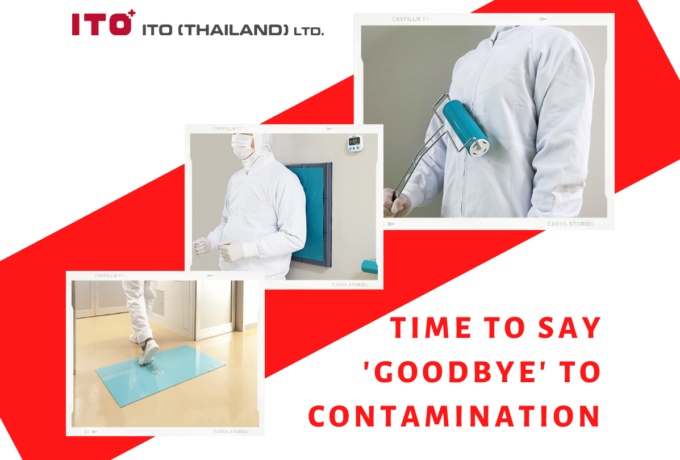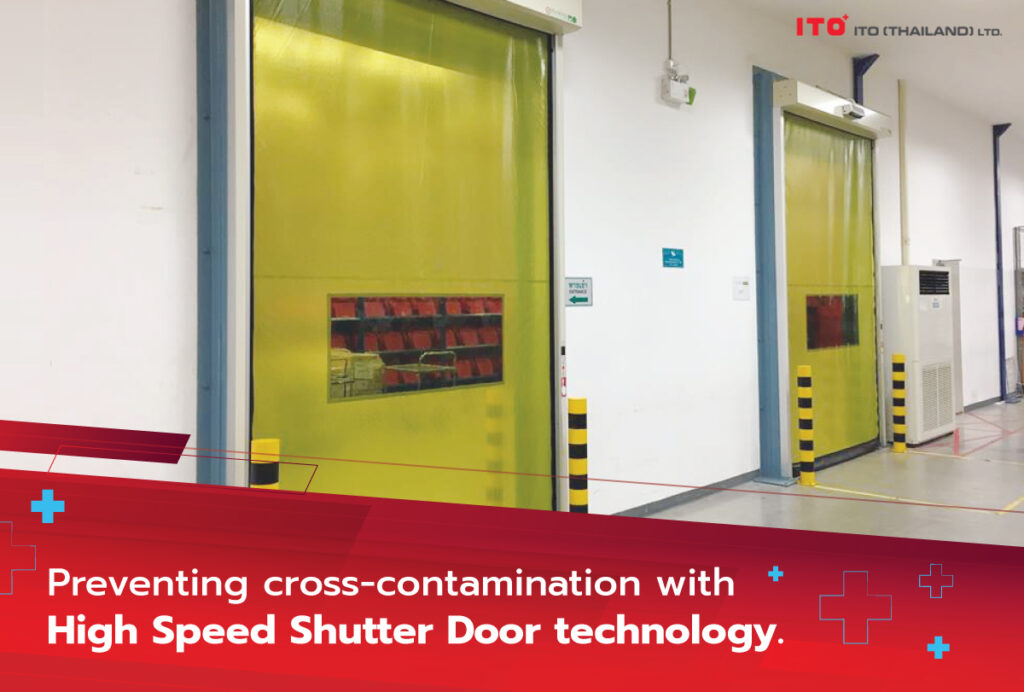ITO Thailand Hygiene Blog
High Speed Door: Prevent Contamination with Technology
Suitable characteristics of entrance doors for externally connected doors must be able to prevent rodents (with a gap of less than 6 mm) and should have a self-closing system, but in the case that it is not possible, other methods may be used, such as installing an air curtain or strip curtain on the door to help reduce the risk of contamination. However, these devices have limitations to prevent contamination. For example, strip curtain is often left open for a long time due to the convenience of the staff or damages from use, making it vulnerable to contamination. In the case that it is not in use, the door should always be closed. And in the case of frequent use, it should be a door that can close quickly to reduce the risk of external contamination [1].
For ITO Thailand’s Monban high speed door, in addition to being a door that opens and closes with a high speed of up to 3.2 m/s due to the use of a specially designed motor, which effectively reduces the amount of time that the atmosphere inside the building or the room is exposed to the outside environment, it also has a tight closure on both sides and bottom, which makes it possible to prevent contamination well. Furthermore, the product has many additional functions that the operator can choose to install together with the high speed door to better prevent contamination from the environment as follows:
Air Tight Structure System
With a special Air Tight Structure System that can withstand different levels of air pressure, wind pressure and pressure and has been tested according to JIS A 1516 (Windows and doorsets — Air permeability test) of the Japanese Standards Association (JSA), when the air pressure difference does not exceed 10 Pa, the structure will be able to withstand a maximum positive pressure of 5.76 cubic meters/hour*square meters and can withstand negative pressure up to 8.35 cubic meters/hour*square meters, which is suitable for environments that require maximum cleanliness, such as clean rooms, high-risk rooms and so on.
Insect-proof Paint Magic Optron
Monban’s patented insect-proof canvas paint is a product created from the cooperation of KOMATSU ELECTRIC INDUSTRY CO., LTD., TAISEI FINE CHEMICAL CO., LTD. and IKARI SHODOKU CO., LTD. and has passed research and experimentation in Japan. It has been found to be effective for light-sensitive insects such as planthopper, leafhopper, moth, crane fly, chironomid and so on by using the principle of insect reaction to light wavelengths to control insects by specifying the exterior to be a color that can cut off the light waves seen by insects, so it does not attract them. For the interior canvas, it has the color range that insects fly into, which helps reduce the chance of insects flying into the building. In the case that insects find a way in or come with other carriers (such as humans, material boxes and so on), the insects will be attracted to the door area and will not fly into the building, and they will leave the building easily when the door is open. From the experiment, it was found that it can prevent 80.7% of these insect groups, which is one of the good choices to reduce the problem of insect contamination without using chemicals.
Sensor System that Reduces Touching
Door area is one of the most exposed areas and is at risk of contamination of germs and unwanted substances into the hands of employees. Using automatic sensors can help reduce this risk. It also saves time in the process of opening and closing, for example, in the case of forklift drivers transporting goods, employees can drive into the sensor area, and the door can be opened automatically without the need for operators to get out of the forklift. Monban’s sensor system is an infrared radiation system that supports small, medium and large doors. It has a number of sensor spots from 4-60 including sensors that guarantee the safety of automatic door to close the door when there are no obstacles under the door to prevent accidental closing of doors on employees. This promotes efficiency in providing safety to both food products and the work area of the employees. Besides, it can also be implemented as an integration system with other instruments such as forcing employees to conduct a temperature measurement or use alcohol gel before the door can be opened in order to increase the standard of cleanliness before entering the area.
Sterilization with UV-C System
Due to the ongoing epidemic situation, the company has developed a new function that can be attached to highspeed doors, which is to install a system to kill microorganisms and viruses with UV-C light using the principle of pulling in air to kill germs with a UV-C lamp at a wavelength of 254nm inside the box above the entrance door to prevent UV-C radiation from affecting the operator walking in and out of the door and release clean air after the sterilization process. According to the results of laboratory experiments in Korea, it was reported to reduce airborne bacteria by 58.2% in 1 hour and airborne viral droplets by 41.8% in 30 minutes (under a 60 square meter closed room experiment).
Preventing Contamination to Cold Rooms
Cold room doors are usually Isowall doors and are overlaid with strip curtains, but because Isowall doors are often heavy and strip curtains often obstruct the staff while entering and leaving, it sometimes can make employees careless when opening and closing the cold room especially cold rooms with frequent entry and exit, where employees might keep the door open and pile strip curtains up together to make it easier to get in and out. As a result, there is a lot of contamination entering the cold room and loss of temperature. To solve this problem, the use of Monban doors designed specifically for cold rooms can replace the use of strip curtains because it is tightly sealed and can protect against contamination more efficiently. With a special material that can withstand cold temperatures up to -25 degrees Celsius, it comes with a motor system that has a built-in heater and a system to prevent ice sticking around the door that will affect the efficiency of opening and closing the door in the long run.
ITO would like to be a part of promoting the food safety society in Thailand in order for Thai food industry to grow sustainably.
Please click here to know more about us.
References
1.Holah, J. T. (2014). Hygienic factory design for food processing. In Hygiene in Food Processing(pp. 53-90). Woodhead Publishing.
Related Post
-

Liquid nitrogen in food industry
You maybe have heard that liquid nitrogen can rapidly freeze the food, haven’t you? And what are its advantages and benefits? Let's get to know the liquid nitrogen in food industry with ITO (Thailand).
-

Ultrafine bubble (UFB) technology (Part 2)
The previous content has discussed the benefits of the ultrafine bubble technology in agriculture, livestock, and fisheries, cleaning raw materials and various surfaces. Today, we will continue to learn about the use of the ultrafine bubble technology in food production processes and waste management from the food industry and how to create these tiny gas bubbles.
-

Ultrafine bubble (UFB) technology (Part 1)
Simple bubbles when transformed into the micro-nano level can do more than you think. Let's learn about the technology of these tiny bubbles and their application in the food industry with ITO (Thailand).
-

Frozen food storage management
Freezing is a method of food preservation commonly used in food that goes bad quickly such as ready-to-cook fresh food, ready meals, or foods in which nutritional values decay easily, or have substances that are sensitive to temperature, light, oxygen, etc. Freezing uses a principle of quickly solidifying water in the products, making the molecules of the substances unable to react to one another, thus the foods last longer. It also suppresses the growth of microorganisms and kills parasites. For instance, USFDA suggested controlling parasites in fish consumed raw such as sushi and sashimi by freezing the fish at the minimum of 20 degrees Celsius for 7 days or stored at -35 degrees Celsius for 15 hours to control parasites in fish (conditions may depend on the size of the fish as well).
-

Boot Cleaner
Pay attention to the hygiene of the footwear for good hygiene in the food industry
-

Innovation for sustainable physical contamination prevention
It is known that external impurities pose a food safety risk. One of the main channels of contamination is the presence of humans as a carrier of dust and dirt into the production or high-risk areas, causing dirt, germs, or foreign matters to contaminate food and harm consumers.










